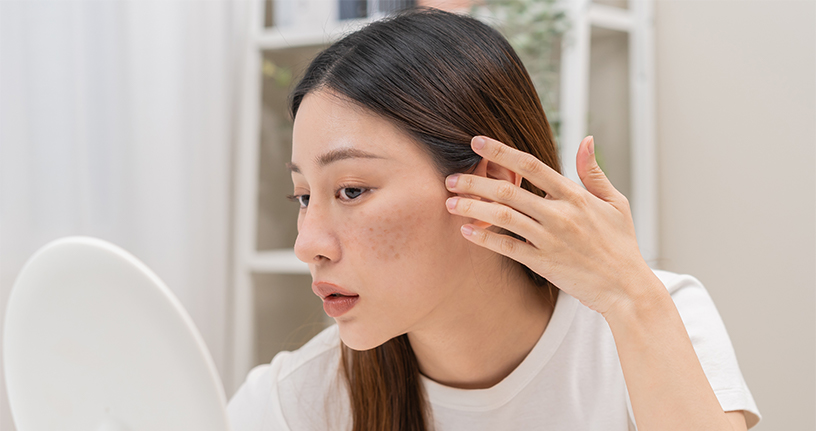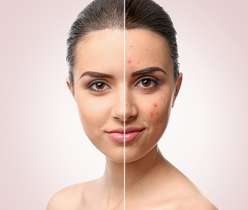Melasma is a common skin condition characterized by the development of brown or gray-brown patches on the skin, primarily affecting areas frequently exposed to the sun. It is most prevalent among women, particularly those with darker skin tones, but it can affect anyone. Understanding melasma, its triggers, and appropriate treatments is essential for managing the condition effectively and minimizing its impact on your skin.
Characteristics of melasma:
- Appearance:
Color: The patches are typically brown or gray-brown.
Shape and size: The patches are usually irregularly shaped and can vary in size, often forming symmetrical patterns on both sides of the face.
Common locations: Melasma most commonly appears on the face, particularly on the cheeks, forehead, bridge of the nose, upper lip, and chin. It can also occur on the neck, forearms, or other areas exposed to the sun.
- Types of melasma:
Epidermal: The pigmentation is located in the superficial layers of the skin (epidermis). It often appears dark brown and is more responsive to treatment.
Dermal: The pigmentation is deeper in the skin (dermis) and appears bluish-gray. It is usually more challenging to treat.
Mixed: A combination of epidermal and dermal pigmentation as brownish-gray patches. This is the most common form of melasma.
Transepidermal: The pigmentation may involve both epidermal and dermal layers but has some features that make it unique compared to mixed melasma.
Causes of melasma
-
- Sun exposure:
-
-
- UV Radiation: Ultraviolet (UV) radiation from the sun is a major trigger for melasma, as it stimulates the melanocytes (pigment-producing cells) to produce more melanin (pigment).
-
-
-
- Worsening Condition: Even minimal exposure to sunlight can exacerbate melasma, making sun protection a crucial part of management.
-
-
- Hormonal factors:
-
-
- Pregnancy: Often referred to as “the mask of pregnancy,” melasma is common during pregnancy due to hormonal changes. This form of melasma is known as chloasma.
-
-
-
- Birth control pills and HRT (hormone replacement therapy): The use of oral contraceptives and HRT can trigger melasma due to hormonal fluctuations.
-
-
-
- Menstrual Cycle: Hormonal changes during the menstrual cycle can also influence the condition.
-
-
- Genetic predisposition:
-
-
- Family history: There is often a genetic component to melasma, with individuals with a family history of the condition being more susceptible.
-
-
- Other factors:
-
-
- Cosmetic products: Some skincare and cosmetic products can irritate the skin, increasing the risk of melasma.
-
-
-
- Medications: Certain medications, such as anti-seizure drugs, can make the skin more prone to developing melasma.
-
-
-
- Thyroid dysfunction: There is some evidence that thyroid dysfunction may cause melasma.
-
Managing melasma requires a consistent skincare routine and protective measures. Implement the best skin care routine for melasma to achieve the desired results.
Here are the top 10 skincare tips to help manage melasma effectively:
-
- Use sunscreen daily
-
-
- Broad-spectrum protection: Choose a sunscreen with at least SPF 30 that offers broad-spectrum protection against UVA and UVB rays.
-
-
-
- Reapplication: Reapply every two to three hours, especially outdoors, sweating, or swimming.
-
-
-
- Physical sunscreens: Consider using sunscreens containing zinc oxide or titanium dioxide, as they provide a physical barrier against the sun.
-
-
- Avoid direct sun exposure
-
-
- Protective clothing: Wear wide-brimmed hats, sunglasses, and protective clothing to shield your skin from the sun.
-
-
-
- Shade: Seek shade whenever possible, especially between 10 AM and 4 PM when the sun’s rays are strongest.
-
-
- Incorporate topical melasma treatments or melasma treatment cream
-
-
- Hydroquinone: A commonly prescribed ingredient for lightening dark spots caused by melasma.
-
-
-
- Retinoids: Help with skin cell turnover but are used under the guidance of a dermatologist to avoid irritation.
-
-
-
- Azelaic acid: Helps reduce pigmentation and is less irritating for sensitive skin.
-
-
-
- Kojic acid & arbutin: Natural skin lighteners that can be effective when used regularly.
-
-
-
- Tretinoin: It helps renew the skin tissues as it contains vitamin A derivate, a substance that offers a natural glow and softens the skin.
-
These ingredients or combinations offer the best melasma cream, like Triluma 15 gm cream, Melamet, Melalite forte cream, etc. Consult your doctor to know the best ingredient for your skin type.
-
- Avoid skin irritants
-
-
- Gentle skincare products: Use mild cleansers, moisturizers, and skincare products that do not contain alcohol, fragrances, or harsh chemicals.
-
-
-
- Patch test new product: Before using a new product, perform a patch test to ensure it doesn’t irritate your skin.
-
-
- Moisturize regularly
-
-
- Hydration: Keep your skin well-moisturized to support the skin barrier and prevent dryness that can exacerbate melasma.
-
-
-
- Non-Comedogenic: Choose non-comedogenic moisturizers (won’t clog pores) suitable for your skin type.
-
-
- Exfoliate with care
-
-
- Gentle exfoliation: Use mild exfoliants like glycolic acid or lactic acid to remove dead skin cells and enhance the effectiveness of topical treatments.
-
-
-
- Frequency: Limit exfoliation to 1-2 times a week to avoid over-exfoliation, which can worsen melasma.
-
-
- Consider professional treatments
-
-
- Chemical peels: Superficial chemical peels using glycolic acid or salicylic acid can help lighten melasma. Always get these done by a licensed professional.
-
-
-
- Laser therapy: Certain laser treatments can target pigmentation, but an experienced dermatologist should perform them due to the risk of worsening pigmentation.
-
-
- Manage hormonal triggers
-
-
- Hormonal therapy: Consult with your healthcare provider if you believe hormonal changes (e.g., pregnancy, birth control) are triggering your melasma. Adjustments to your regimen may be needed.
-
-
-
- Stress management: Stress can impact hormone levels, so practice stress-relief techniques such as meditation, exercise, or yoga.
-
-
- Healthy diet and hydration
-
-
- Antioxidant-rich foods: Incorporate foods rich in antioxidants (like vitamins C and E) to support skin health and reduce inflammation.
-
-
-
- Hydration: Drink plenty of water to keep your skin hydrated and promote overall skin health.
-
-
- Consistency is key
-
-
- Routine: Stick to a consistent skincare routine, as managing melasma is a long-term process.
-
-
-
- Patience: Results may take time, so be patient and avoid switching products too frequently, which can irritate the skin.
-
By following these tips, you can manage melasma more effectively and achieve healthier, even-toned skin. Regular consultations with a dermatologist can also help tailor a skincare plan specific to your needs.
Where to buy/order Melamet online OR where to buy/order Trilum 15 gm cream online?
Buy prescribed topical formulations from Reliablerxpharamacy at affordable prices. You can contact the customer support team with any queries you may have regarding product, shipment, pricing, or delivery.




